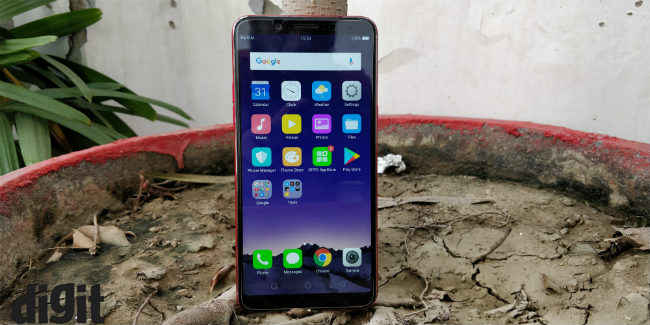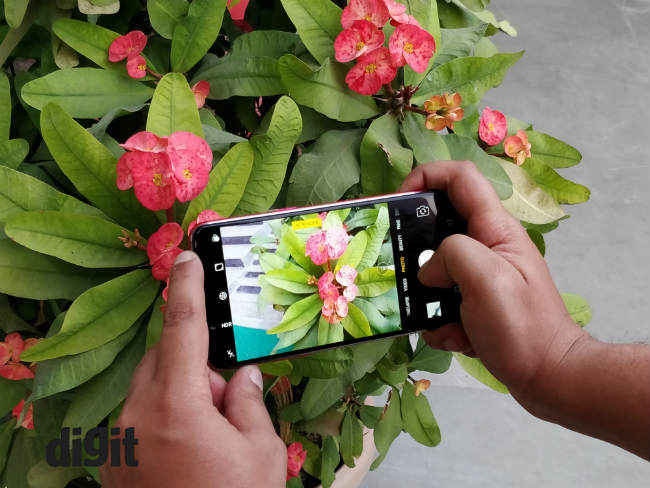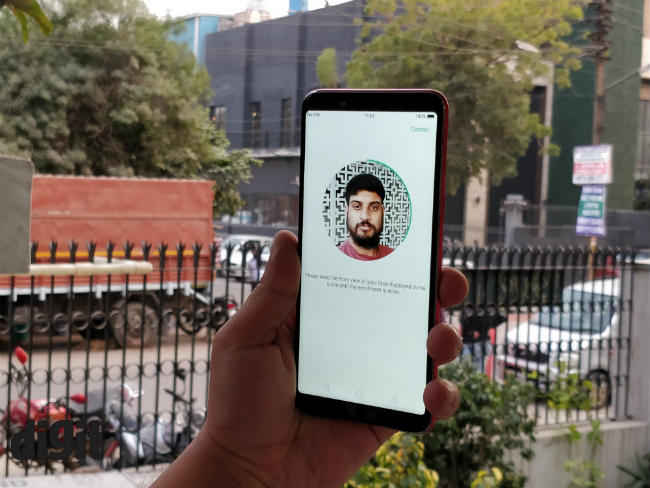Oppo F5 Review : Feels artificial
The Oppo F5 will give you every feature that’s in trend right now — An 18:9 display with slim bezels, a bright red colour variant and a high resolution selfie camera. But that’s just on paper. When you try using the phone in real life, the features seem half baked. Moreover, the Rs 24,999 seems too expensive for the internal hardware the phone sports. If you don’t want to accept the natural imperfections of your face, this selfie-centric phone should keep you happy, but anything authentic and you will be cursing the phone like anything.
Oppo has made a lot of lofty claims about the phone and in this review, we find out if they are just marketing jargon or are there some truth in the matter too. At Rs 24,999, the phone better prove its worth.
Build and design: Poorly built, compromising design
The Oppo F5 is slim and sleek with a shiny chrome red finish housing a tall univisium display. But all is not what meets the eye here.
Even though the Oppo F5 launched just six months after its predecessor, that too starting at the same price, there seems to be an underlying sense of compromise. That’s primarily because the Oppo F5 ditches the metal unibody design for a matte plastic one. The chrome red finish tries to hide that fact and at first glance, it would be difficult to tell. There’s also a silver strip running at the top and bottom tips of the phone, imitating the antenna lines on phones with metal bodies. The same silver string borders the oval-shaped fingerprint sensor as well. Also, unlike most phones the fingerprint sensing plate is almost at the same plane as the rest of the body. It doesn’t sink as deep as in other phones and finding it is an acquired sense. The rear camera is at the top left corner and the LED flash right beside it. It’s very iPhone 7-like, right from the camera placement, to the location of the Oppo moniker and the matte finish.
The compromise becomes even clearer after a few months of use. The polycarbonate body starts showing signs of wear and tear. The colour chips away leaving silver specks around the body. You will have to slap a case on the phone if you wish to preserve its fascia.
Oppo somewhat makes up for the downgrade in the build quality with a taller 6-inch display in a wider 18:9 aspect ratio, packing 2160×1080 pixels in that size. The screen takes up most of the 6.1-inch body with minimal top and bottom chins and extremely thin side bezels. It’s quite minimalist from the front as well. So much so, that the notification LED is missing along with the physical capacitive buttons. While the latter is acceptable, the former is a sore pain. There’s no Always-on display to compensate for it, and you are forced to turn on the screen to check for messages.
The phone also bulges out from the sides which messes with the ergonomics. Because of the bulge, it is difficult to reach the other end of the display despite its thinner profile. The whole advantage of a taller, thinner display is undone.
Quite frankly, Oppo’s design doesn’t make much sense. The build quality does not justify the Rs 24,990 price tag it carries. The closest competitor of the phone is the four-eyed Honor 9i (review), which is quite sturdy and looks more refined.
Display: One of the only redeeming factor
If trends are what you are after, the Oppo F5 should keep you satisfied. The 6-inch tall univisium display is all the rage these days and Oppo has managed to fit it in a compact 6.1-inch body. It’s one of the redeeming factors in the phone. The Full HD+ resolution does justice to the display, packing 402 pixels per inch. Icons and text looks crisp, but the colour reproduction seems a bit off. At full brightness, the colours tend to be quite oversaturated. The green colour of the Dialer app icon is a clear indicator.
The Oppo F5 uses an IPS LCD panel which brings in the advantage of good viewing angles and better sunlight legibility. The white point of the display is on the cooler side though. There’s a distinct blue tint over the display. If you can get over that, the Oppo F5 has a good enough panel. The contrast is deep with the blacks tending to get quite dark. Oppo does give you the option to tweak the colour temperature, but you’re better off keeping it at the default settings.
Trendy or not, the taller 18:9 display is becoming quite common in phones these days. Phones with univisium displays start from under Rs 10,000 these days and a commanding a price double than that for a new display format isn’t justified.
Camera: Artificially dumb
While its predecessor, the Oppo F3 features dual cameras on the front, the Oppo F5 keeps things simple with a single camera setup both at the front and the back. We’re not complaining as such as we’ve seen single camera setups resulting in some stellar Since this is one of Oppo’s ‘Selfie-Expert’ device, the focus is more on the front camera than the rear camera. And quite literally so. The 16-megapixel shooter at the back comes with f/1.8 aperture and PDAF, but it’s quite a hassle to keep the frame in focus. The autofocus on this phone is very unstable and more often than not, you will find the focusing mechanism go halfway before starting all over again. But when it does manage to focus though, the 16-megapixel shooter takes shots that are quite decent.
The camera app interface is very much like the iOS counterpart Oppo loves to draw inspiration from. You have the various modes arranged right above the shutter button while the camera app settings is housed in the main Settings app, very much like iOS.
The rear camera takes well-detailed photos, although the dynamic range leaves a lot to be desired. The colours are especially nice, but the contrasts seems a bit too high. Also, under harsh lighting there are significant highlight clipping. You can see in the shot below the details in Shrey’s shirt is non-existent.
Since this has a single camera setup, there’s no portrait mode. Moreover, HDR shots sometimes tend to get a bit too dark. It’s the high contrast at play here. Despite all that, if the focus is on point, the camera isn’t as bad. You will get good details out of well-lit indoor shots, but don’t expect the same from low light though. You will find photos taken under poor lighting have grains with the details inconsistent and a lot of blur in the photo, especially if it’s a moving object you are trying to capture.
Shot against bright sunlight with HDR on. The shadows could have been lit up better.
Oppo claims the phone uses complex algorithms to accentuate human beauty 'in all its forms'. The F5 supposedly uses artificial intelligence to study around 200 positioning spots to highlight facial landmark and contours to create a 'perfectly refined and natural selfie'. However, the results are anything but natural. In reality, you will get a selfie that looks a bit too perfect, almost photoshopped. The algorithms are quick to recognise your face though. And it works overtime to remove every spot and blemish from your face, rendering a flawless portrait, much like what happens in the cover pages of fashion magazines. There is an iris brightening tool as well, that made me look devilish. I suppose there's now a market for the so-called 'perfect-selfie' and if that's what you are looking for, the F5 won't disappoint. .
The same overexposure will be there when you are trying to take selfies as well. Sometimes a little too much
The phone also has a depth-mode in the front camera for portrait selfies with the background blurred. It would have been a nice feature to have if not the algorimths in the camera blurred everything out too aggressively.
Safe to say, the Oppo F5 won’t replace a point-and-shoot anytime soon.
Performance and UI
If you put your faith in MediaTek chipsets, the Oppo F5 is quite an upgrade from its predecessor. The phone uses a mid-range octa-core Helio P23 SoC coupled with 6GB of RAM and 64GB of storage. That’s just about enough firepower for a device priced at Rs 24,990. The MediaTek chipset can perform most tasks without slowing down, but you will find occasional lags and stutters. If not for the heavily customised UI, the Oppo F5 would have been quite the performer.
The MediaTek Helio P23 is built on a 16nm process with a max clock speed of 2.5GHz, which means the performance has remained mostly the same as compared to its predecessor, the Helio P20. Clearly, it’s not the fastest phone in its price. The Moto X4 with the Snapdragon 630 is visibly faster and more fluid. What the Helio P23 does bring though, is superior communication hardware. The Helio P23 supports dual 4G LTE and Dual SIM, Dual Standby. That means, the phone supports Dual VoLTE. With telecom operators rolling out 4G connectivity across the country, this will be an overlooked, but useful feature to have.
The test unit we received refused to run Geekbench 4. So we had to depend on the rest of our performance benchmarking apps. Pitting the phone against the Sony Xperia XA1 Ultra, which was powered by the Helio P20 chipset, it’s clear that the newer chipset in the Oppo F5 doesn’t bring much of a performance upgrade. Raw performance may pit the Oppo F5 higher than most Qualcomm-powered devices, but the devil lies in the details. Per 3D Mark's Slingshot benchmark test which puts that raw power to work, the Oppo F5 falls far behind the competition.
But even though it’s beaten by other phones in synthetic benchmark scores, the real-world usage is quite impressive. Despite a heavy UI, the Helio P23, in tandem with 6GB RAM handles daily tasks without a hitch. Gaming performance too was commendable, although games took a little longer to load. Although, as the storage gets filled and there are more apps running on the phone, with notifications flooding the lockscreen, the phone might not square up to the task.
The Oppo F5 runs on ColorOS 3.2 which runs dangerously close into iOS territory. The phone feels like a cheap imitation of the iPhone and if you are an Android user, it takes a little time to get used to it, precisely because of the iOS-like Control Panel that you need to swipe up to access. Unlike the standard Android UI, settings shortcuts — Wi-Fi and Bluetooth toggles, brightness bar, etc. are all housed in the Control Panel.
The UI also brings in iPhone X-like gestures into play which isn't as consistent as you'd wish. The on-screen navigation buttons are much more reliable. But then, if you are playing games, prepare to have the navigation buttons pop up randomly from below.
ColorOS 3.2 is a big departure from the standard Android UI. It also runs on an older Android 7.1.1 which is just sad. You do get features like split-screen, new emojis, app shortcuts and more which are a standard across most Android devices nowadays. The phone also has a file sharing feature called O-Share which basically uses the Wi-Fi hotspot to transfer files.
Face Unlock
If you are copying Apple, it’s better to go all the way too. And that is exactly what Oppo has done. By making use of a dormant Android feature, Oppo has tried to match up to Apple’s FaceID, but falls far behind. The phone makes use of Android’s 'Trusted Face' feature to bring face unlock. Since it only uses the front camera, the facial recognition can be easily tricked and it’s not very secure. The enrollment is pretty easy though and you are given an option to set it up when you boot the phone for the first time. But it isn’t as consistent as the one on OnePlus 5T. More often than not, the Oppo F5 will refuse to unlock using your face citing poor lighting. It’s a good novelty feature to have, but isn’t something we recommend using exclusively to unlock the phone. The fingerprint sensor, on the other hand, is super fast and very reliable.
Battery: Lasts a day, that's about it
The Oppo F5 packs a 3,200mAh battery to power you through the day and for the most part, it does last around a day. On our benchmark test for battery, the Oppo F5 lasted 5 hours and 28 minutes of intensive activity with the screen on. By that metric, you can expect the Oppo F5 to last you an average work day.
There is no fast charging support however. Oppo's VOOC charging is known to be notoriously fast, but the tech seems to be out of the budget for the F5. Instead, you get a normal 5A charger which fills up the tank in about two hours.
The phone also uses a micro-USB port which isn't ideal. By now, phones should universally adopt the USB-Type C standard. It's more efficient and you can plug it in any way you like!
Bottomline
The Oppo F5 is a good-looking impersonation of a reliable Android phone. It might feel smooth and slick, but a few weeks of using the phone will change that impression. The 6GB memory will keep the phone from being outdated for another year, but the fact that it comes with an older Android version already makes it outdated. Oppo anyway never had a good track record of providing regular Android updates. Moreover, the AI features that Oppo F5 boasts of, doesn’t do anything good. It performs the same Photoshop trickery that beauty magazines get called out for. You’re better off keeping it natural, to be honest. The display is perhaps the only redeeming factor for the phone. Rest of the phone is one compromise after another.













